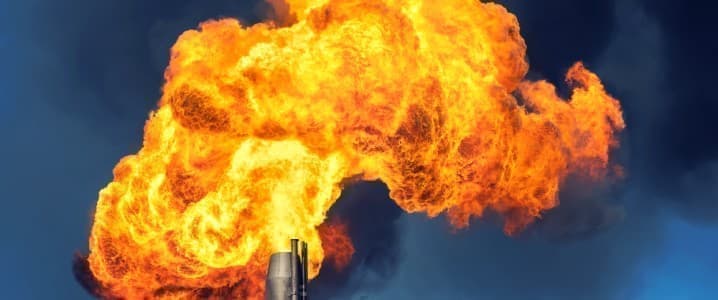
Global satellite data indicates a significant increase in methane emissions from the onshore upstream oil and gas sector during late 2024 and the first quarter of 2025. This marks a reversal of a steady decline observed since 2020. According to analysis by Rystad Energy, emissions from this sector rose notably, with China experiencing a nearly one-third increase year on year, while the United States saw a smaller rise of 4%. In contrast, Russia recorded a 5% decrease in emissions during the same period, largely attributed to reduced production stemming from the ongoing conflict in Ukraine.
The satellite detection revealed approximately 45,000 methane plumes in the first quarter of 2025, an increase of 14,000 from the previous year. Combined, these plumes emitted around 45 million tonnes of carbon dioxide equivalent (CO2e), representing a 40% increase compared to the first quarter of 2024. Regions such as the Middle East, North Africa, China, Russia, and North America showed significant variations in emission density and rates, reflecting differing production volumes and infrastructure conditions.
Regional Insights and Challenges
Despite high absolute methane emissions in certain countries, many of these regions maintain low methane intensity due to high production volumes. However, aging infrastructure at processing facilities, compressor stations, and well operations has resulted in a disproportionately high methane footprint in some Central Asian and North African countries relative to their hydrocarbon output. The upstream oil and gas production sector is responsible for approximately 20% of all human-caused methane leaks.
Detection remains a significant challenge in addressing these emissions. Once identified, most leaks can be remedied, contrasting with carbon dioxide emissions, which primarily result from combustion and are more challenging to mitigate. Consequently, reducing methane emissions has emerged as a pressing concern for oil and gas producers. Methane has a shorter atmospheric lifespan but possesses a much greater warming potential than CO2, necessitating immediate actions rather than long-term strategies.
Patrick King, Vice President of Emissions Research at Rystad Energy, highlighted that many large leak events often go unreported in exploration and production company disclosures, which must be rectified to provide a clearer understanding of methane emissions.
Rystad Energy’s detailed data analysis reveals that methane emissions exhibit seasonal patterns in many countries. These fluctuations are likely influenced by climate conditions, regional operational differences, and the timing of mitigation efforts. Factors such as cloud cover, wind, and humidity can also affect satellite measurement accuracy.
China stands out as a key contributor, recording the highest methane emissions from oil and gas production in early 2025. Emissions typically peak during winter and decline in summer, correlating closely with natural gas production cycles. Despite a 50% increase in gas production since 2018, satellite data shows a 30% decline in methane emissions, suggesting improvements in operational practices. This trend aligns with initiatives by state-owned companies China National Petroleum Corporation (CNPC) and Sinopec, both of which launched methane reduction programs in 2019 and 2020.
Implications for Policy and Future Action
In the West, the increase in methane emissions has been driven largely by significant plumes over the Bakken shale region in January 2025, despite milder winter conditions compared to previous years. In the United States, methane abatement has become a political priority, exemplified by the Waste Emission Charge introduced under the Biden administration in late 2024. However, this policy applied only to reported emissions, not those detected by satellites, and was overturned in February 2025.
As the U.S. shale industry matures, the environmental consequences of industry consolidation during 2023 and 2024 will be closely scrutinized. Large public exploration and production companies have expanded their abatement initiatives, yet their future under the Trump administration remains uncertain, particularly with movements aimed at dismantling the U.S. Environmental Protection Agency’s Greenhouse Gas Reporting Program.
Despite the limited scope of federal policies and the potential for rollbacks, the U.S. shale industry is expected to continue reducing its emissions intensity, building on notable improvements observed in 2023. Preliminary data from the Lower 48 states suggests stability in methane emissions for 2024 compared to 2023, even as production levels rise.
Globally, while figures indicate an increase in methane emissions for the first quarter of 2025, several nations have maintained the downward trends established in prior years. For instance, Iraq has consistently reduced its methane emissions since 2019, coinciding with a decline in oil production and an increase in gas output. However, the first quarter of 2025 saw emissions surge nearly 50% compared to the previous year, primarily due to activities in the Zagros Foldbelt Basin, including flaring and ramped-up production.
In South and Central Asia, countries such as India, Uzbekistan, and Pakistan have reported declines in methane emissions from 2022 to 2024. Following record lows last year, emissions in the first quarter of 2025 rebounded to levels closer to early 2023. In Uzbekistan, the launch of the Tolibtepa gas field in 2023 contributed to increased emissions amid rising production.
India is also enhancing its focus on methane management, with plans for a National Inventory Management System aimed at improving systematic tracking of greenhouse gas emissions. As these countries navigate the complexities of methane emissions, a coordinated approach will be crucial for reducing their environmental impact while meeting energy demands.






